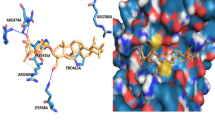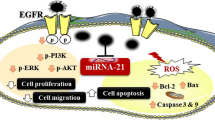Abstract
C-C motif chemokine ligand 5 (CCL5) is crucial in the tumor microenvironment. It has been previously reported to act as a key role in tumor invasion and metastasis. However, the function of exogenous CCL5 in ovarian cancer has not been well-characterized. The present study attempted to express and purify recombinant CCL5 protein and investigate the exogenous CCL5 in ovarian cancer cell proliferation. The human CCL5 was amplified and inserted into the pET-30a vectors for prokaryotic expression in Escherichia coli BL21. Soluble His-CCL5 was successfully expressed with 0.1 mmol/L of isopropyl-β-D-1-tiogalactopiranoside at 25 ℃ and purified by affinity chromatography. Additionally, methyl thiazolyl tetrazolium (MTT) assay demonstrated that CCL5 promotes ovarian cancer cell proliferation; increases the phosphorylation levels of extracellular-signal-regulated kinase and mitogen-activated protein kinase/ERK kinase, and increases the mRNA levels of Jun, NF-κB2, Nras, Relb, and Traf2. Furthermore, treatment with the MEK inhibitor reduced the Jun, NF-κB2, and Traf2 mRNA levels, indicating that exogenous CCL5 increased ovarian cancer cell proliferation, through MEK/ERK pathway activation, and Jun, NF-κB2, and Traf2 expression. The present study provided primary data for further studies to discover more CCL5 functions in ovarian cancer.






Similar content being viewed by others
References
Yi EH, Lee CS, Lee JK, Lee YJ, Shin MK, Cho CH, Kang KW, Lee JW, Han W, Noh DY, Kim YN, Cho IH, Ye SK (2013) STAT3-RANTES autocrine signaling is essential for tamoxifen resistance in human breast cancer cells. Mol Cancer Res 11(1):31–42
Conlon KC, Miljkovic MD, Waldmann TA (2019) Cytokines in the treatment of cancer. J Interferon Cytokine Res 39(1):6–21
Ouyang W, O’Garra A (2019) IL-10 family cytokines IL-10 and IL-22: from basic science to clinical translation. Immunity 50(4):871–891
Schall TJ, Bacon K, Toy KJ, Goeddel DV (1990) Selective attraction of monocytes and T lymphocytes of the memory phenotype by cytokine RANTES. Nature 347(6294):669–671
Kakinuma T, Hwang ST (2006) Chemokines, chemokine receptors, and cancer metastasis. J Leukoc Biol 79(4):639–651
Luboshits G, Shina S, Kaplan O, Engelberg S, Nass D, Lifshitz-Mercer B, Chaitchik S, Keydar I, Ben-Baruch A (1999) Elevated expression of the CC chemokine regulated on activation, normal T cell expressed and secreted (RANTES) in advanced breast carcinoma. Cancer Res 59(18):4681–4687
Niwa Y, Akamatsu H, Niwa H, Sumi H, Ozaki Y, Abe A (2001) Correlation of tissue and plasma RANTES levels with disease course in patients with breast or cervical cancer. Clin Cancer Res 7(2):285–289
Aldinucci D, Borghese C, Casagrande N (2020) The CCL5/CCR5 axis in cancer progression. Cancers (Basel) 12(7):1765
Aldinucci D, Casagrande N (2018) Inhibition of the CCL5/CCR5 axis against the progression of gastric cancer. Int J Mol Sci 19(5):1477
Zheng Y, Han GW, Abagyan R, Wu B, Stevens RC, Cherezov V, Kufareva I, Handel TM (2017) Structure of CC chemokine receptor 5 with a potent chemokine antagonist reveals mechanisms of chemokine recognition and molecular mimicry by HIV. Immunity 46(6):1005–1017e5
d’Alayer J, Expert-Bezançon N, Béguin P (2007) Time- and temperature-dependent acetylation of the chemokine RANTES produced in recombinant Escherichia coli. Protein Expr Purif 55(1):9–16
Webb PM, Jordan SJ (2017) Epidemiology of epithelial ovarian cancer. Best Pract Res Clin Obstet Gynaecol 41:3–14
Jelovac D, Armstrong DK (2011) Recent progress in the diagnosis and treatment of ovarian cancer. CA Cancer J Clin 61(3):183–203
Long H, Xie R, Xiang T, Zhao Z, Lin S, Liang Z, Chen Z, Zhu B (2012) Autocrine CCL5 signaling promotes invasion and migration of CD133 + ovarian cancer stem-like cells via NF-κB-mediated MMP-9 upregulation. Stem Cells 30(10):2309–2319
Long H, Xiang T, Qi W, Huang J, Chen J, He L, Liang Z, Guo B, Li Y, Xie R, Zhu B (2015) CD133 + ovarian cancer stem-like cells promote non-stem cancer cell metastasis via CCL5 induced epithelial-mesenchymal transition. Oncotarget 6(8):5846–5859
Zhou B, Sun C, Li N, Shan W, Lu H, Guo L, Guo E, Xia M, Weng D, Meng L, Hu J, Ma D, Chen G (2016) Cisplatin-induced CCL5 secretion from CAFs promotes cisplatin-resistance in ovarian cancer via regulation of the STAT3 and PI3K/Akt signaling pathways. Int J Oncol 48(5):2087–2097
GhoshalA, Ghosh SS (2015) Expression, purification, and therapeutic implications of recombinant sFRP1. Appl Biochem Biotechnol 175(4):2087–2103
Xu T, Xiao M, Yu L (2021) Method for efficient soluble expression and purification of recombinant hyperactive Tn5 transposase. Protein Expr Purif 183:105866
Liu W, Wang L, Zhang J, Qiao L, Liu Y, Yang X, Zhang J, Zheng W, Ma Z (2021) Purification of recombinant human chemokine CCL2 in E. coli and its function in ovarian cancer. 3 Biotech 11(1):8
Chen L, Cai S, Wang JM, Huai YY, Lu PH, Chu Q (2020) BRDT promotes ovarian cancer cell growth. Cell Death Dis 11(11):1021
Burotto M, Chiou VL, Lee JM, Kohn EC (2014) The MAPK pathway across different malignancies: a new perspective. Cancer 120(22):3446–3456
Labrou NE (2014) Protein purification: an overview. Methods Mol Biol 1129:3–10
Kimple ME, Brill AL, Pasker RL (2013) Overview of affinity tags for protein purification.Curr Protoc Protein Sci73: 9.9.1–9.9.23.
Jia B, Jeon CO (2016) High-throughput recombinant protein expression in Escherichia coli: current status and future perspectives. Open Biol 6(8):160196
Wingfield PT (2015) Overview of the purification of recombinant proteins. Curr Protoc Protein Sci 80: 6.1.1–6.1.35
Smith DB, Johnson KS (1988) Single-step purification of polypeptides expressed in Escherichia coli as fusions with glutathione S-transferase. Gene 67(1):31–40
Harper S, Speicher DW (2011) Purification of proteins fused to glutathione S-transferase. Methods Mol Biol 681:259–280
Wang SW, Wu HH, Liu SC, Wang PC, Ou WC, Chou WY, Shen YS, Tang CH (2012) CCL5 and CCR5 interaction promotes cell motility in human osteosarcoma. PLoS ONE 7(4):e35101
Zazo S, González-Alonso P, Martín-Aparicio E, Chamizo C, Luque M, Sanz-Álvarez M, Mínguez P, Gómez-López G, Cristóbal I, Caramés C, García-Foncillas J, Eroles P, Lluch A, Arpí O, Rovira A, Albanell J, Madoz-Gúrpide J, Rojo F (2020) Autocrine CCL5 effect mediates trastuzumab resistance by ERK pathway activation in HER2-Positive breast cancer. Mol Cancer Ther 19(8):1696–1707
Wu YH, Huang YF, Chen CC, Huang CY, Chou CY (2020) Comparing PI3K/Akt inhibitors used in ovarian cancer treatment. Front Pharmacol 11:206
Deng Z, Sui G, Rosa PM, Zhao W (2012) Radiation-induced c-Jun activation depends on MEK1-ERK1/2 signaling pathway in microglial cells. PLoS ONE 7(5):e36739
Hsu FT, Chiang IT, Kuo YC, Hsia TC, Lin CC, Liu YC, Chung JG (2019) Amentoflavone effectively blocked the tumor progression of glioblastoma via suppression of ERK/NF-κB signaling pathway. Am J Chin Med 47(4):913–931
Li X, Bao C, Ma Z, Xu B, Ying X, Liu X, Zhang X (2018) Perfluorooctanoic acid stimulates ovarian cancer cell migration, invasion via ERK/NF-κB/MMP-2/-9 pathway. Toxicol Lett 294:44–50
Borghi A, Verstrepen L, Beyaert R (2016) TRAF2 multitasking in TNF receptor-induced signaling to NF-κB, MAP kinases and cell death. Biochem Pharmacol 116:1–10
Ge QL, Liu SH, Ai ZH, Tao MF, Ma L, Wen SY, Dai M, Liu F, Liu HS, Jiang RZ, Xue ZW, Jiang YH, Sun XH, Hu YM, Zhao YX, Chen X, Tao Y, Zhu XL, Ding WJ, Yang BQ, Liu DD, Zhang XR, Teng YC (2016) RelB/NF-κB links cell cycle transition and apoptosis to endometrioid adenocarcinoma tumorigenesis. Cell Death Dis 7(10):e2402
Acknowledgements
This research was supported by grants from the Scientific and Technological Research Project of Henan Province (No. 212102310898), the Key scientific research project of Henan Province (No. 22A180017), and the research start-up fund to topnotch talents of Henan Agricultural University (No. 30500424).
Author information
Authors and Affiliations
Contributions
Z.M. and L.X. designed the study. Z.M., J.Z. and L.W. performed the experiments. Y.L., G.X. and K.C. performed systematic research of the literature. Z.M. wrote the paper. W.Z. and L.X. revised it.
Corresponding author
Ethics declarations
Conflict of interest
The authors declare no conflict of interest.
Additional information
Publisher’s Note
Springer Nature remains neutral with regard to jurisdictional claims in published maps and institutional affiliations.
Electronic Supplementary Material
Below is the link to the electronic supplementary material.




Rights and permissions
About this article
Cite this article
Ma, Z., Zhang, J., Wang, L. et al. Expression and purification of recombinant human CCL5 and its biological characterization. Protein J 41, 337–344 (2022). https://doi.org/10.1007/s10930-022-10047-8
Accepted:
Published:
Issue Date:
DOI: https://doi.org/10.1007/s10930-022-10047-8




